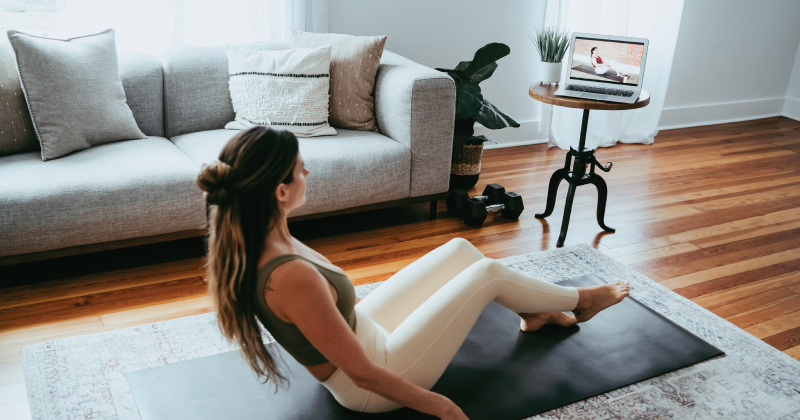Postpartum Exercise 101: How to Safely and Effectively Exercise After Childbirth

Life often looks very different after having a baby. With a new addition to the family, you can expect some major changes to unfold in many areas—from your routine, sleep, and sex life, to your health and nutritional needs.
While some new mamas might be itching to hop back into their pre-pregnancy workout routine, other mothers might be feeling concerned about their body’s ability to handle exercise after giving birth.
It’s completely understandable to have your own share of concerns about the safety and feasibility of exercise after having a baby. After all, nurturing and birthing a baby is often compared to running a marathon, but one that lasts for a whole nine months.
That said, your body is intricately designed to facilitate pregnancy and childbirth, which also means it possesses the incredible ability to heal and recover from physically-demanding experiences. So, in most cases, working out isn’t an activity you’d have to rule out during the postpartum period.
If performed appropriately, exercise is also a powerful tool you can wield to help support your recovery process.
In this article, we’ll dig a little deeper into the benefits and safety of postpartum exercise. We’ll also explore some of the best exercises you can perform to slowly and safely ease yourself back into the groove of working out.
What are the Benefits of Postpartum Exercise?
Many new moms believe that postpartum exercise will only make their situation worse by causing more fatigue and exhaustion.
However, the opposite is usually true.
Prolonged periods of rest and inactivity may actually lead to more tiredness. On the other hand, moving your body and keeping active after having a baby is a great way to boost your energy levels and mood [1].
According to research evidence, postpartum exercise may be linked to the following benefits: [1]
Combats fatigue and increases energy levels
Improves your mood and mental alertness
Promotes weight loss
Reduces the risk of chronic illnesses in the future
Helps you stay fit
Another big concern of new mothers is what’s known as diastasis recti, also nicknamed the “mommy pooch.” A structured and targeted workout routine can also help to foster the healing of both the natural separation that happens during pregnancy as well as the more injury-based grade of diastasis recti.
If addressing diastasis recti is something you’re concerned about, check out Studio Bloom’s guided programs. These meticulously designed programs teach fundamental breathwork techniques and proper core engagement exercises that can aid in preventing and healing injury-based diastasis recti.
How Soon Can You Start Exercising After Giving Birth?
According to the American College of Sports Medicine, many new mamas who have experienced an uncomplicated delivery generally receive the green light to exercise around 4-6 weeks after giving birth [1].
The American College of Obstetricians and Gynecologists notes that women who have had a healthy pregnancy and vaginal delivery may even start exercising a few days after giving birth, or as soon as they feel ready [2].
Women who kept active before and during their pregnancy can often return to their pre-pregnancy workout routines pretty quickly after getting clearance from their healthcare professional [1].
However, if you had a cesarean section or experienced certain complications during your birthing process, your body may require more time to recuperate and recover [1]. And it’s essential that you provide your body with enough rest and time to heal.
Your body has encountered major changes throughout your pregnancy and delivery, so do be patient and compassionate with yourself along the way. In any case, if you have any hesitation or concerns about exercising postpartum, you can seek advice and clearance from your doctor.
Most importantly, stay attuned to what your body tells you so you don’t push yourself too far beyond your limit. Your body speaks; your role is to listen.
At Studio Bloom, we are strong believers in getting adequate rest and restoration during the first six weeks after delivery. But we also believe in engaging and strengthening the core and pelvic floor prior to the 6-week check-up and, of course, before you jump back into your pre-pregnancy workout routine.
How Much Should I Exercise Postpartum?
The American College of Obstetricians and Gynecologists recommends that you aim to stay active for 20-30 minutes each day during the earlier stages. It’s best to start with lower-intensity exercises before gradually working up to higher-intensity routines [2].
Caring for a baby can be hard work. And with household chores, work commitments, and other additional responsibilities in the mix, it’s completely normal to feel like you might lack the bandwidth for a workout.
What matters most is doing the best you can; even a short 10 minutes routine is a great way to keep yourself moving and active after having a baby.
Best Postpartum Exercises to Include in Your Routine
The best postpartum exercises can help you achieve various goals—whether that’s to repair a pregnancy-related injury, boost your energy and mood, or reconnect and re-engage with your postpartum body.
Let’s explore the different types of exercises that can help you heal and regain your strength and stamina postpartum.
Diastasis Recti and Postpartum Exercise
Diastasis recti refers to the separation of the abdominal muscles (or six-packs) that pregnant mothers experience [3]. It’s what we know as the “mommy tummy” or “mommy pooch.”
Some level of separation between your abdominal muscles is completely natural and normal as your body makes room for a growing baby during your pregnancy. On the other hand, injury-based diastasis recti happens when the linea alba (midline connective tissue) becomes over-weakened during pregnancy and does not retain its integrity as it should after delivery.
This can be detected by measuring the width of the gap (inter-recti distance) between the abdominal muscles as well as the depth and integrity of the linea alba. We’ve put together a comprehensive 3-phase guide detailing how to self-test for injury-based diastasis recti.
If you have injury-based diastasis recti, diaphragmatic breathing exercises can help to regulate intra-abdominal pressure. This transformative method of breathing involves a shift in breathing, so it comes from your diaphragm rather than your chest and utilizes your entire abdomen, side body, and back body.
Apart from diaphragmatic breathwork, proper core engagement is another key pillar to regulating IAP and preventing or healing injury-based diastasis recti. Deep core hold is one of the foundational techniques that can help you build muscle endurance in the deep core by maintaining an intentional connection for a sustained amount of time.
In this video, our founder, Brooke Cates, demonstrates how to engage the deeper core to help heal postpartum injuries.

Postpartum Pelvic Floor Exercises
Incontinence after pregnancy happens so commonly that it’s often chalked up as “normal” and not something you can fix. In fact, research suggests that around one in three women experience some form of urinary incontinence after childbirth [4].
During pregnancy, the weight of your growing baby may strain the pelvic floor muscles, the group of muscles that support your uterus and bladder. The pelvic floor muscles actually do the “heavy lifting” during your pregnancy, which is why many mamas experience some degree of pelvic floor trauma after having a baby.
Thus, some mothers may experience what’s called stress urinary incontinence, which refers to leaking urine when they cough, sneeze, laugh, have sex, or perform any physical activities that may apply extra pressure on the bladder [5]. If you notice this set of symptoms, do realize that this condition is absolutely fixable and isn’t something you need to live with.
Research has found that pelvic floor exercises are effective for curbing symptoms of urinary incontinence, especially stress incontinence [6].
At Studio Bloom, we make it a point to teach new mamas how to stretch, relax, rehab, and strengthen their pelvic floor muscles through our various guided programs.
The Studio Bloom Solution
We’ve curated a range of meticulously-designed programs to help mamas throughout different phases of their motherhood journey, up to 12 years postpartum. Studio Bloom’s workouts are safe for all postnatal women, including those with diastasis recti, umbilical hernias, and pelvic floor dysfunction, but they will also help you recover from these pregnancy-related injuries.
Our 4th-Trimester Rehab program equips new moms to safely progress through exercises that will help them heal and re-engage with their postpartum bodies and their core. These exercises can be done from your bed and can even encourage bonding with your baby.
After reconnecting with the core and pelvic floor, 6-week postpartum moms and veterans who want to maximize results from head to toe can check out Bloom’s Mom Lab program. This dives deep into your core and overall body awareness, which will help you address injury-based diastasis recti and attain the mom bod of your dreams.
You can follow this up with Ab Code, designed to help you strengthen your core further and deepen your understanding of core connection, core strength, and core stamina.
Postpartum Exercise and Nutrition Tips
When getting into postnatal exercise, these are some tips that can help you out:
Start with lower-intensity workouts. You can gradually increase the intensity of your workouts over time. Keep in mind that low and moderate-intensity exercises are less likely to affect milk production [1].
If you are breastfeeding, it’s best for you to breastfeed your baby or express your milk before working out to reduce discomfort [2].
You’ll need even more than the 500 extra calories required per day to maintain your milk supply when exercising. Listen to your body, and ensure you have substantial and nutritious meals throughout the day.
You may consume a high-quality protein powder after a workout, which can help repair, build, and restore your muscles after exercise.
Remember to stay well-hydrated. According to the Academy of Nutrition and Dietetics, a nursing mom needs about 16 cups a day, including that from beverages, food, and fruits [7]. If you work up a sweat while exercising and can’t keep up with this, electrolytes can be helpful for quick rehydration and replacing lost minerals.
Is Postnatal Exercise Safe?
For mothers with a healthy pregnancy and uncomplicated delivery, it is generally safe to exercise as early as a few days after giving birth [2]. Of course, it’s still best to seek clearance from your healthcare professional before hopping back into exercising to ensure that it is safe for you.
Suppose you’re unsure about what’s best for you. In that case, Studio Bloom’s guided programs will help you safely progress through a range of exercises designed to minimize pregnancy-related injuries, combat injury-based diastasis recti, and strengthen your pelvic floor muscles.
Exercise is an important form of self-care to prioritize after delivering your precious bundle of joy. Studio Bloom meets you wherever you are and empowers you to safely and progressively tap into an active lifestyle so that you can be the healthiest and happiest version of yourself for you and your baby!
Throughout the journey, what's most important is to give yourself lots of patience and grace as you learn to listen to your body and navigate the early days of motherhood.
Want to Experience Studio Bloom?
Save 30% on your first month with code POSTPARTUM30.
References
[1] Roy, B. A. (2014). Postpartum Exercise. ACSM’s Health & Fitness Journal, 18(6), 3–4. https://doi.org/10.1249/fit.0000000000000071
[2] Exercise After Pregnancy. (n.d.). ACOG. https://www.acog.org/womens-health/faqs/exercise-after-pregnancy
[3] Laframboise, F. C., Schlaff, R. A., & Baruth, M. (2021). Postpartum Exercise Intervention Targeting Diastasis Recti Abdominis. International journal of exercise science, 14(3), 400–409.
[4] Soave, I., Scarani, S., Mallozzi, M., Nobili, F., Marci, R., & Caserta, D. (2019). Pelvic floor muscle training for prevention and treatment of urinary incontinence during pregnancy and after childbirth and its effect on urinary system and supportive structures assessed by objective measurement techniques. Archives of gynecology and obstetrics, 299(3), 609–623. https://doi.org/10.1007/s00404-018-5036-6
[5] Lugo T, Riggs J. Stress Incontinence. [Updated 2022 Jun 27]. In: StatPearls [Internet]. Treasure Island (FL): StatPearls Publishing; 2023 Jan-. Available from: https://www.ncbi.nlm.nih.gov/books/NBK539769/
[6] Price, N., Dawood, R., & Jackson, S. R. (2010). Pelvic floor exercise for urinary incontinence: a systematic literature review. Maturitas, 67(4), 309–315. https://doi.org/10.1016/j.maturitas.2010.08.004
[7] Nursing Your Baby What You Eat and Drink Matters. (n.d.). https://www.eatright.org/health/pregnancy/breastfeeding-and-formula/nursing-your-baby-what-you-eat-and-drink-matters



